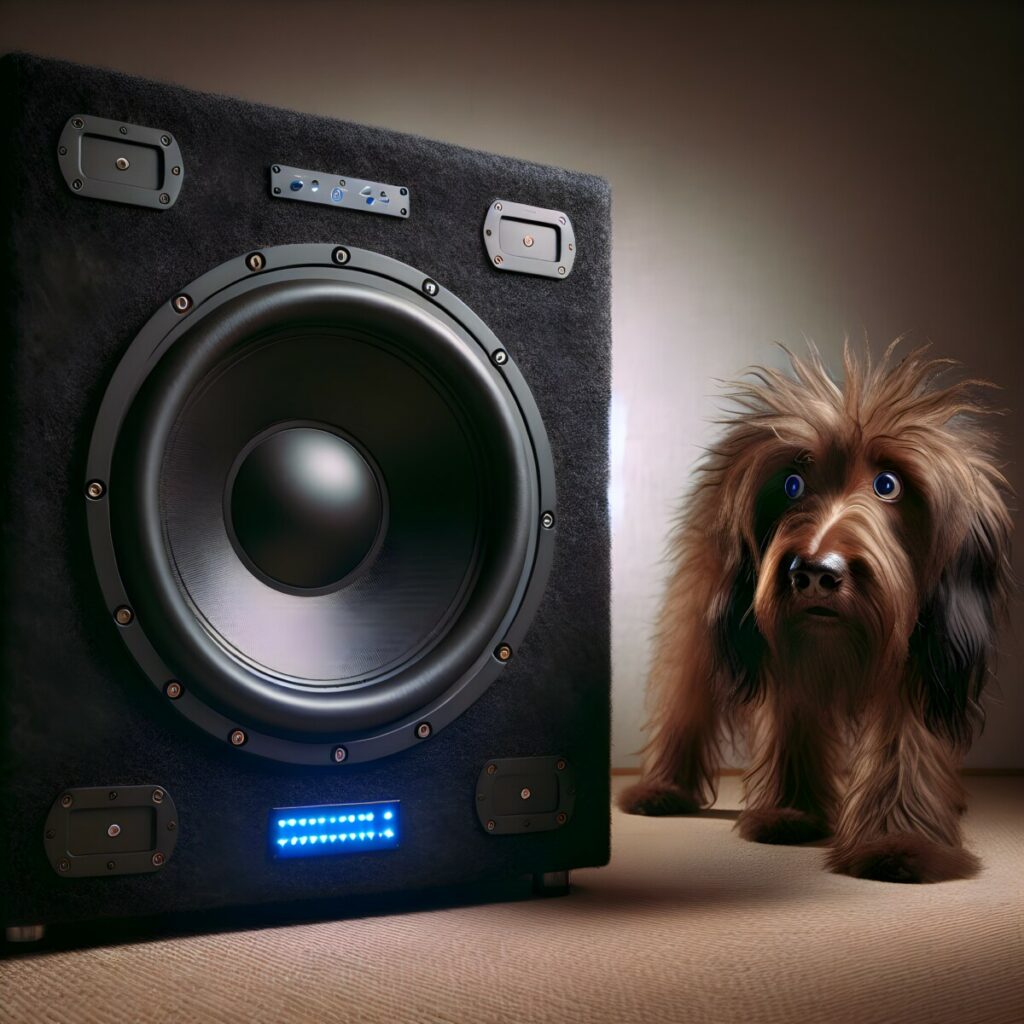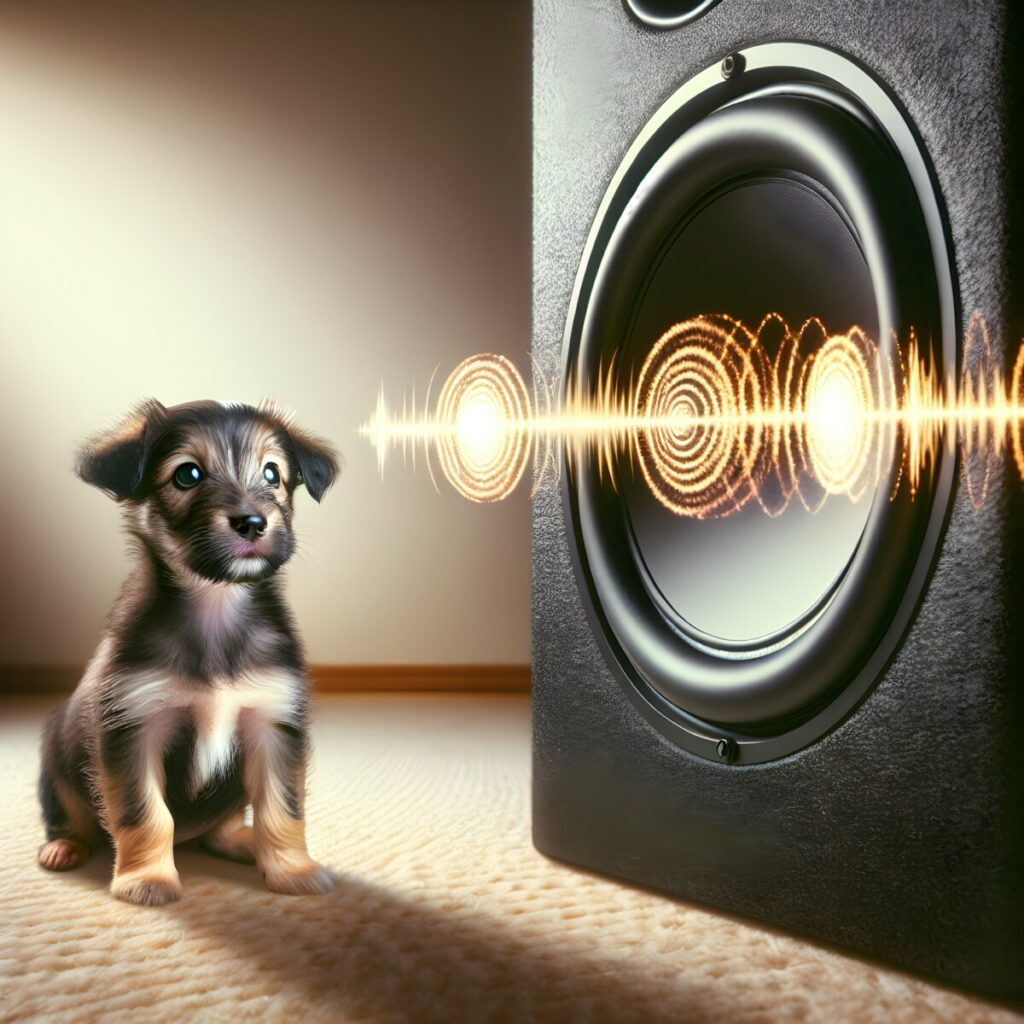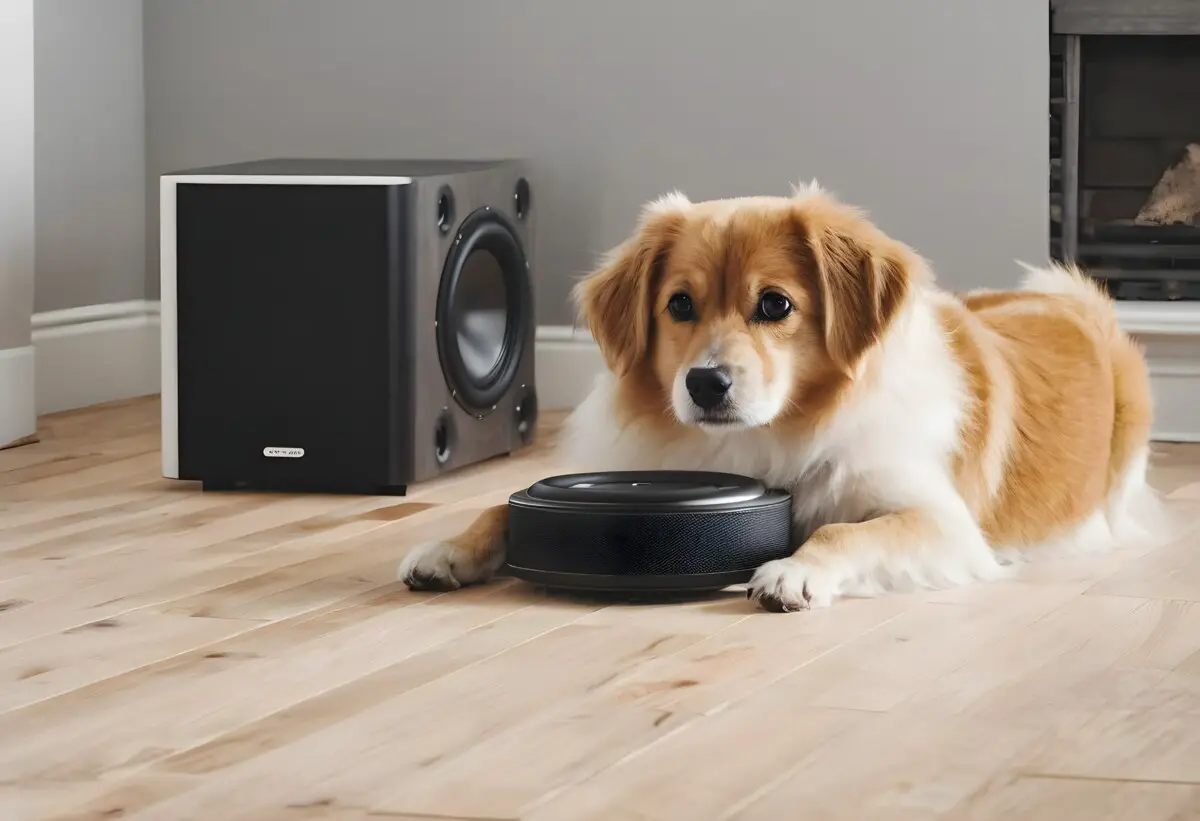As an Amazon Associate I earn from qualifying purchases
Every audio lover wants to have a subwoofer in their house but there are considerations to be made, specifically if you have animals.
One of the key concerns many have is if subwoofers are bad for dogs.
Are subwoofers bad for Dogs?
Subwoofers can potentially be bad for dogs and damage their hearing. This largely depends on how loud your subwoofer is and if your dog is too close to it.
There are several tell-tale signs that your dog is being negatively affected by a subwoofer, these include excessive barking, whining, and other odd behavioral changes.
Luckily there are steps you can take to prevent this and keep the dog in your life happy.
You can put your dog in a separate room, adjust the subwoofer settings, but most importantly invest in a subwoofer that is less likely to disturb them.
Subwoofers can be bad for Dogs

Subwoofers, in themselves, are not inherently bad for dogs.
However, the volume and intensity at which subwoofers operate can potentially be harmful to dogs’ sensitive ears.
Dogs have a keen sense of hearing, and exposure to loud sounds, including those produced by subwoofers, can cause them stress, anxiety, and discomfort.
Prolonged exposure to high-volume sounds may lead to hearing damage in dogs, just as it can in humans.
Responsible pet owners should be mindful of the sound levels in their homes, ensuring that they don’t subject their pets to excessively loud noises, including those generated by subwoofers.
It’s advisable to monitor your dog’s behavior and comfort level when using audio equipment and to keep the volume at a level that doesn’t distress or disturb your furry companion.
How Subwoofers Can Damage a Dog’s Hearing

Unlike humans, dogs can hear sound at a lower frequency than we can, making certain sounds emitted by subwoofers intense enough to cause potential damage to their sensitive auditory system.
The deep vibrations that are synonymous with subwoofers can reverberate through the air as sound pressure.
This pressure is not just something dogs sense; it can have a tangible, damaging impact on their ears.
The danger posed by subwoofers largely stems from their ability to generate sound at levels that can be harmful to a dog’s hearing.
High volumes of loud music and the intense noises that can fill a room have the potential to become a source of anxiety and fear in dogs.
To understand why dogs hate certain sounds, one must consider that a dog’s ears are remarkably sensitive.
They are designed to pick up vibrations and sounds that humans simply cannot detect, making the deep tones of subwoofers not just audible to them, but also potentially overwhelming.
The biology of how dogs’ ears work is complex, but it boils down to this — dog ears are fine-tuned instruments that can easily be disrupted by intense frequencies, especially those produced by subwoofers in the octaves that can overlap with a dog’s heightened hearing range.
It’s important for the wellbeing of our pets to remember that our pet’s hearing should take precedence over our desire for a rich acoustic environment.
Subwoofers, by their very nature, can produce frequencies that are not just audible to dogs but can operate at a volume and pitch that is uncomfortable for them.
Caring for a dog’s auditory health means being mindful of these risks and moderating the use of subwoofers and *loud music*, which may be particularly overwhelming for their delicate ears.
Identifying Signs That Subwoofer Noises Hurt Dogs

- Behavioral Changes: One of the most telling signs that your dog might be distressed by a subwoofer is a change in behavior. Observe if your dog starts hiding in corners, seeking refuge in places where they feel secure. This behavior can be indicative of their attempt to escape the overwhelming sound waves.
- Vocalization: Dogs communicate primarily through barking, whining, and howling. If you notice an increase in your dog’s vocalizations, especially in the presence of the subwoofer’s deep bass, it could be a sign of their discomfort. Excessive barking or whimpering indicates that the sound waves might be causing them stress or anxiety.
- Increased Heart Rate and Panting: Elevated heart rate and excessive panting are physiological responses to stress in dogs. These symptoms can be triggered by the vibrations generated by powerful subwoofers, indicating that your pet is not at ease.
Observing a dog’s behavior closely can reveal subtle hints that certain sounds are having a detrimental effect on their well-being.
If a dog demonstrates discomfort by whining, pacing, or cowering when the subwoofer is active, these could be viewed as signs that the subwoofer is bad for dogs.
There’s considerable anecdotal evidence on forums where pet owners share posts about their dogs’ adverse reactions to loud music.
These accounts often point to a correlation between sound pressure levels in the home and distress in dogs.
Many pet owners have shared that they often see a change in behavior that suggests their dogs hate the rumbling associated with subwoofers.
Although not all dogs will react negatively, some might exhibit signs of anxiety, such as a tucked tail, droopy ears, or escape attempts, which all merit attention.
Is Subwoofer Bass Harmful to Puppies and Dogs?

The question of whether subwoofer bass is harmful to our canine companions is one that merits serious consideration, particularly for pet owners who are audiophiles.
Although they may not be able to hear sub bass at the exact frequencies we do, the sound pressure emitted by subwoofers can still be perceived, possibly leading to discomfort or even auditory damage.
Dogs, much like puppies, rely heavily on their sense of hearing, and introducing them to environments with persistent, loud, low-frequency noise could be dangerous.
Subwoofers, by design, are meant to reproduce low frequency sounds, which are typically less directional and can permeate through walls, potentially affecting your dog even when they are not in the same room as the sub.
Owners should be aware of the danger when the subwoofer’s volume is set too high, as this could contribute to a scenario where the bass becomes detrimental to a dog’s ears.
Despite the joy that subwoofers add to our auditory experiences, pet owners must balance their aural indulgence with the auditory health of their four-legged friends.
Measures to Protect Dog Ears from Subwoofer
- Monitor Your Dog’s Behavior: The first step is to observe your dog closely. If you notice any of the signs mentioned above, consider that your dog might be distressed by the subwoofer.
- Create a Safe Space: Provide your dog with a safe and quiet space where they can retreat to when the subwoofer is in use. This can be a designated room or a cozy corner with their favorite toys and blankets. Creating a comforting environment can alleviate their anxiety.
- Adjust the Subwoofer Settings: If possible, adjust the subwoofer settings to minimize the bass output. Lowering the volume or using soundproofing materials in the room can significantly reduce the impact of the subwoofer’s vibrations.
- Consult a Veterinarian: If your dog’s distress persists despite your efforts, consult a veterinarian. They can assess your dog’s overall health and recommend appropriate medications or therapies to manage anxiety.
One of the first measures to consider is the strategic placement of the subwoofer in your home.
Since dog’s ears are sensitive to far-field noises, placing the speaker in a location where your pet does not frequently occupy can minimize their exposure to direct sound waves.
Additionally, when using the subwoofer, it’s advisable to keep pets in a different room, ensuring their environment remains quiet and stress-free.
It’s also essential to maintain a *well-calibrated subwoofer* sound level.
A sound that is too loud can be as harmful to dogs as it is to humans.
Using a sound level meter can assist in establishing a threshold that is safe for all members of the household, including the four-legged ones.
Another important aspect to consider is the content being played.
Sounds that may seem benign to humans can be distressing or even harmful to dogs, so it’s important to be mindful of the audio content that resonates through the subwoofer.
Moreover, it’s beneficial to initiate regular checks of your dog’s ears to watch for any signs of discomfort or hearing loss.
Being vigilant about pets hearing health allows you to take timely action if adverse effects from subwoofer use becomes evident.
Dogs with pre-existing hearing issues should be given especial consideration, as their ears are more susceptible to further damage.
Consider purchasing a lower-powered subwoofer
To be considerate of both your pets and neighbors I’d recommend getting a subwoofer that will not cause your pet to go nuts.
Something like a Sonos Sub Mini (affiliate link) is a good choice because it is designed for smaller rooms and Sonos products are easily adjustable with their bass response.
- Mix and match Sonos speakers to create a wireless sound system for immersive home theater, multiroom listening, and more.
- Dual force-canceling woofers generate surprisingly deep, dynamic low end with no buzz or rattle so you feel more immersed in every scene and song.
- Advanced processing further enhances the acoustics, reproducing the full-tuned low frequencies expected from a much larger subwoofer.
- Trueplay tuning technology optimizes the bass for the unique acoustics of your space so it never sounds harsh, muddy, or flat.
- Enjoy quick and easy setup with just a single power cable and help from the Sonos app.
- Effortlessly control the sound. The volume automatically adjusts along with your paired speaker or soundbar, and you can use the Sonos app to customize the EQ.
- The 5 GHz WiFi connection enhances audio transmission speed so you can enjoy high-quality sound synced with your Sonos soundbar and TV.
- The unique cylindrical design looks at home in your home, blending in beside your furniture or hiding underneath it.
Conclusion
In conclusion, while subwoofers themselves are not inherently bad for dogs, their powerful sound waves and vibrations can indeed cause distress to our canine companions.
Responsible pet ownership involves recognizing the signs of discomfort, such as behavioral changes, vocalization, and physiological responses like increased heart rate and panting.
By closely monitoring your dog’s reactions and creating a safe, quiet space for them, you can mitigate their anxiety.
Additionally, adjusting the subwoofer settings, investing in soundproofing materials, or considering a lower-powered option like the Sonos Sub Mini can make a significant difference.
Ultimately, being mindful of your pets’ well-being ensures a harmonious home theater experience for both you and your furry friends.
Frequently Asked Questions
Are subwoofers bad for your health?
Subwoofers themselves are not harmful to human health. However, excessive exposure to very loud bass can potentially cause hearing damage. It’s essential to maintain reasonable volume levels for your well-being.
Can loud music make a dog sick?
Yes, loud music, especially with heavy bass produced by subwoofers, can stress out dogs and cause them discomfort. Prolonged exposure may lead to anxiety and behavioral issues. It’s crucial to monitor your pet’s reactions and keep the volume at a level that doesn’t disturb them.



